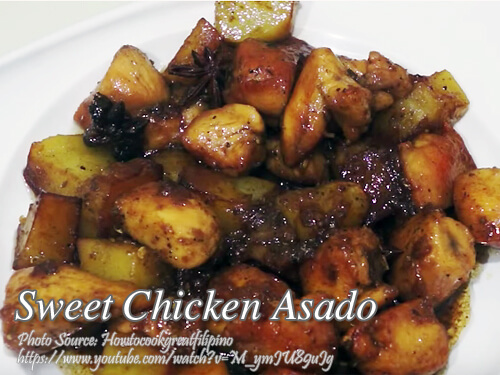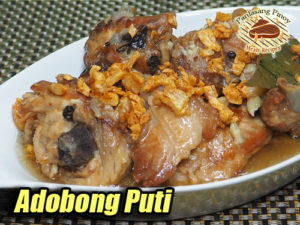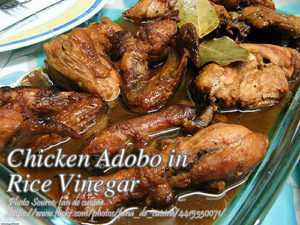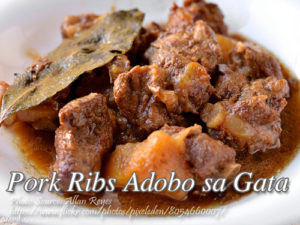This sweet chicken asado recipe is inspired by the usual pork asado and the chicken adobo with potatoes. But unlike those dishes, this one does not contain soy sauce. So the brownish color of this dish is made thru frying the meat and potatoes and the brown sugar. This variation of chicken asado is good for those who does not like soy sauce on their dishes.
Sweet Chicken Asado with Potatoes: A Nostalgic Taste of Home
When I first tasted this sweet chicken asado, it instantly brought me back to Sunday lunches at my Lola Nena’s house in Batangas. The kitchen would always smell of something simmering slowly—sweet, savory, and a little mysterious. But unlike her usual adobo, this one had no soy sauce at all. “Ganyan ‘yan, apo,” she used to say. “Walang toyo, pero malasa.” And she was right. The flavor was deep, comforting, and just the right mix of sweet and spiced goodness.
A Family Twist on a Classic
Traditionally, asado is made with pork and a generous splash of soy sauce for that rich brown color. But this version—sweet chicken asado with potatoes—takes a slightly different path. My uncle Boyet first showed me this style when I visited him in Pampanga, the land of serious cooks. He told me that in their town, they prefer using chicken because it cooks faster and absorbs flavors more easily. “Mas madaling lumambot, mas masarap,” he said while stirring the pot with a smile.
And the secret? The brown sugar and a bit of frying magic. Instead of relying on soy sauce for color, the sugar caramelizes in the pan, coating the chicken and potatoes in a glossy, golden brown sauce. It gives the dish a sweet aroma that instantly fills the kitchen—one that always makes me feel like home.
The Story Behind the Sweetness
You might wonder how this chicken asado became sweet in the first place. The answer lies in Filipino ingenuity. During the Spanish era, asado was introduced as a savory dish often made with roasted or braised meat. But through the years, we Filipinos added our own twist—sugar, pineapple juice, even banana ketchup—to suit our taste for something sweeter and more comforting.
In some parts of Luzon, this dish is cooked with tomato sauce, but in our home, we skip that and let the natural sweetness of brown sugar and the spice of star anise shine. That hint of five-spice powder gives it an almost Chinese influence, a nod to our long history of culinary exchange.
Cooking Sweet Chicken Asado at Home
When my sister Liza visited from Cebu last summer, she asked me to cook something “simple but special.” So, I pulled out this family favorite. We started by seasoning the chicken with salt and pepper—just enough to draw out its natural flavor.
Then, in a medium wok, I heated a bit of oil and fried the chicken until it turned slightly brown. That’s the first secret—browning the meat gives depth and that beautiful, toasty flavor that soy sauce can’t replicate.
After that, we tossed in garlic and potato chunks, stirring them gently until everything smelled incredible. You need to keep stirring, I told her, so nothing sticks or burns. That constant motion helps the flavors mix evenly.
Next, I drained some of the oil, leaving just about a tablespoon. This small step keeps the dish from becoming greasy. Then came the heart of the recipe: water, star anise, five-spice powder, and brown sugar. The aroma was instant—sweet, fragrant, and a little nostalgic. We let it simmer for a few minutes until the sauce thickened slightly, coating each piece of chicken in that irresistible glaze.
Why These Techniques Work
Every step in this recipe has its purpose. Frying the chicken first not only adds color but also locks in the juices, making each bite tender. Adding brown sugar early allows it to caramelize, deepening the flavor and giving the sauce its signature shine. The star anise and five-spice powder balance the sweetness with a hint of warmth and spice, making the dish more complex and satisfying.
It’s a simple technique, but it transforms basic ingredients into something special—just like how Filipino home cooking always turns ordinary into extraordinary.
A Comfort Dish for All Occasions
When we finally sat down to eat, my sister smiled after her first bite. “Parang fiesta,” she said. And truly, this dish has that festive comfort to it. Sweet, savory, and a little bit nostalgic—it’s the kind of meal you’ll want to cook for your family on lazy weekends or when you’re craving something that tastes like home.
This sweet chicken asado with potatoes proves that great flavor doesn’t need fancy ingredients. Just a few pantry staples, a bit of patience, and lots of love. It’s a dish that connects generations—one simmering pot at a time.
How to Cook Sweet Chicken Asado with Potatoes
Ingredients
- 1 kilo boneless chicken breast slice into chunks
- 2 pcs potatoes quartered
- 2 Tbsp. minced garlic
- 2 pcs star anise
- 1/2 cup cooking oil
- 1 tsp. ground black pepper
- 1 tsp. five spice powder
- 1 tsp. salt
- 2 Tbsp. brown sugar
Instructions
How to cook Sweet Chicken Asado with Potatoes:
- Put salt and pepper on the chicken breast and mix.
- In a medium size wok, heat oil and fry the chicken until slightly brown.
- Then add the garlic and potatoes.
- Fry for 7 minutes and stir constantly to avoid burning.
- Then reduce the amount of cooking oil for at least 1 tablespoon.
- Add 1 cup of water, star anise, five spice powder and brown sugar.
- Cook for 5 to 7 minutes until the sauce is slightly thick. Serve hot.
Notes
Cooking Tips:
Brown the Chicken for Extra Flavor
Don’t skip the browning step—it’s what gives your asado that rich, deep flavor. Searing the chicken in hot oil caramelizes its natural sugars and seals in the juices. This simple step makes a big difference, giving the sauce more body and that beautiful golden-brown color.Control the Sweetness
Start with just the recommended amount of brown sugar and adjust later if needed. Every brand of sugar has a slightly different sweetness level, so it’s better to taste as you go. Balancing the sweet with the savory and the spice keeps the dish flavorful, not cloying.Let the Sauce Thicken Naturally
Resist the urge to rush the simmering process—good sauce takes patience. Letting the liquid reduce slowly helps the flavors concentrate and the sugar caramelize perfectly. When the sauce starts to cling to the chicken and potatoes, that’s when you know it’s ready to serve.





